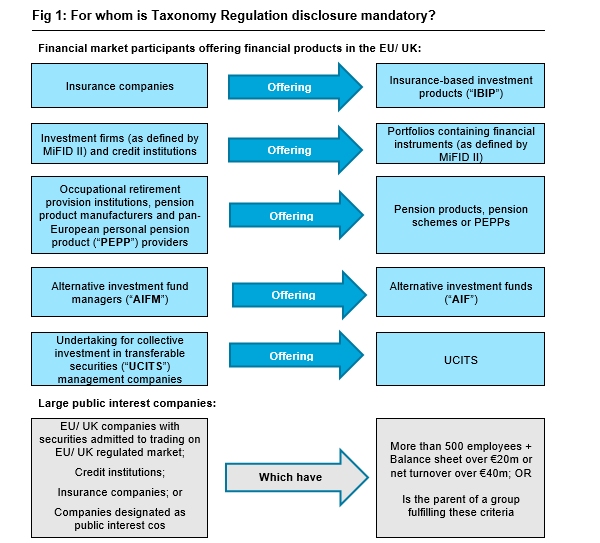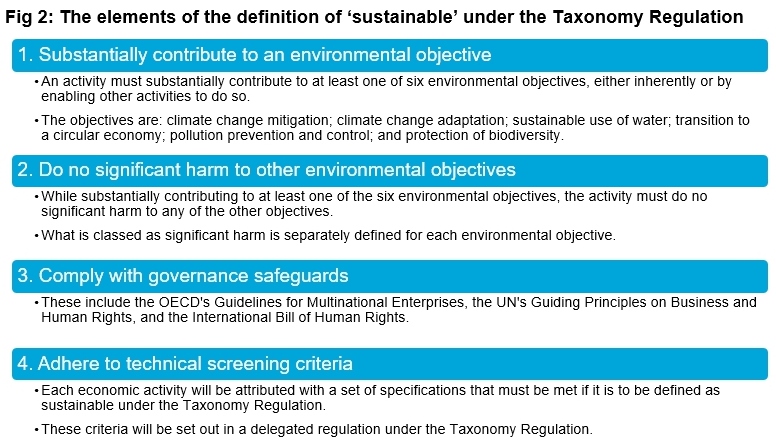
The EU Taxonomy Regulation1 has now entered into force – a long awaited milestone in the sustainable finance market. The EU Taxonomy is a classification tool aimed at investors, companies and financial institutions to define environmental performance of economic activities across a wide range of industries, and sets requirements corporate activities must meet to be considered sustainable. The EU Taxonomy is the EU’s answer to the question “what is green?”.
What is the EU Taxonomy?
The EU Taxonomy is a regulatory classification system under which companies may define which of their economic activities are environmentally sustainable. The regulation also mandates certain companies to report on and disclose the extent to which their business activities are aligned with the Taxonomy’s definition of sustainable.
Who does the Taxonomy Regulation apply to?
Any market participant can use the Taxonomy Regulation to classify their economic activities as sustainable. However, reporting under the Taxonomy Regulation will be a mandatory requirement for two key groups: financial market participants offering financial products within the EU and the UK and large public interest companies, i.e. those required to publish a non-financial statement under the Accounting Directive, as amended by the Non-Financial Reporting Directive2 (see Fig 1 below).
What must be disclosed?
Financial market participants
For financial market participants offering financial products, where the relevant financial products contribute to one of the six ‘environmental objectives’, the entity must disclose:
- Details of the environmental objective(s) to which the underlying investment contributes; and
- A description of the extent to which the underlying investments are in sustainable economic activities. This should specify the share of investments in sustainable economic activities as a percentage of all investments selected in the financial product.
Financial products that do not have sustainable investment objectives must make a negative disclosure statement in pre-contractual and periodic reporting disclosures3.
Bonds are not a specified financial product for the purposes of the Taxonomy Regulation disclosure obligation. However, compliance is recommended for bond issuers in any case since investors and fund managers will need this information when they report on the Taxonomy-alignment of their funds.
Large public interest entities
Large public interest entities4 will be required to disclose in non-financial statements whether, and the extent to which, its activities are environmentally sustainable. Specifically, this will describe the proportion of their turnover, capital expenditure and operating expenditure is associated with Taxonomy-defined sustainable economic activities. As with financial market participants, companies with assets and activities that are not sustainable will have to make a negative statement in reference to the relevant assets. This is in addition to the disclosures required by the Non-Financial Reporting Directive.
What are sustainable activities?
Firstly, the activity must substantially contribute to at least one of six environmental objectives set out in the Taxonomy Regulation: climate change mitigation, climate change adaptation, sustainable use and protection of water and marine resources, transition to a circular economy, pollution prevention and control, and the protection and restoration of biodiversity and ecosystems. Secondly, the activity must not do any significant harm to the other environmental objectives. Thirdly, the activity must comply with minimum social and governance safeguards. Finally, the activity must comply with certain ‘technical screening criteria’.
Where and when should users of the Taxonomy disclose?
Financial market participants should disclose in their periodic reports, pre-contractual disclosures and on their websites by 31 December 2021 in relation to the "climate change mitigation" and "climate change adaptation" objectives, and for the six environmental objectives by 31 December 2022.
Large public interest companies should make their disclosures in a non-financial statement within their annual reports or in a dedicated sustainability report during the course of 2022 in relation to the "climate change mitigation" and "climate change adaptation" objectives, and for the six environmental objectives by 31 December 2023.
Leveraging Taxonomy Regulation disclosure
Although compliance with the Taxonomy Regulation represents additional disclosure, it also presents a number of opportunities and advantages for the disclosing company.
Firstly, if the disclosing company is already operating sustainably within the Taxonomy Regulation criteria, it will attract positive publicity. Being classed as sustainable under the Taxonomy Regulation could also make the disclosing company more investible, in particular to investors and funds with sustainable mandates and investment criteria. Demand for sustainable investments currently outstrips supply, and the Taxonomy Regulation's "sustainable" label could become an internationally recognised hallmark of sustainability.
Secondly, disclosing companies may be able to issue sustainable debt more easily. Other than financial market participants and large public interest companies, the Taxonomy Regulation also applies to policy measures adopted by the EU and member states which relate to the labelling of financial products as sustainable. Primarily, this refers to the EU Green Bond Standard (“GBS”) which is set to be published later in 2020. Only activities that are ‘Taxonomy Regulation-sustainable' may be funded by a GBS-certified green bond, so if the analysis has concluded it is sustainable, the administrative burden of issuing a GBS green bond would be significantly lighter. The Taxonomy Regulation disclosure and accreditation may also provide financial institutions and asset managers a reliable label to identify the assets underlying variety of sustainable securitisation structures, such as green CLOs, ABS or MBS. This possibility will be explored further in part 2 of this article.
The Taxonomy Regulation has been widely lauded as a milestone in sustainable finance. It heralds a new age of transparency and accountability in relation to corporate sustainability and lays the foundations for a plethora of new sustainable finance products, enabling financial markets to move towards a more sustainable and resilient future.
1 Regulation (EU) 2020/852
2 Directive (2014/95/EU)
3 Under Article 7 of the Taxonomy Regulation
4 See Fig 1 for definition.
This publication is provided for your convenience and does not constitute legal advice. This publication is protected by copyright.
© 2020 White & Case LLP


